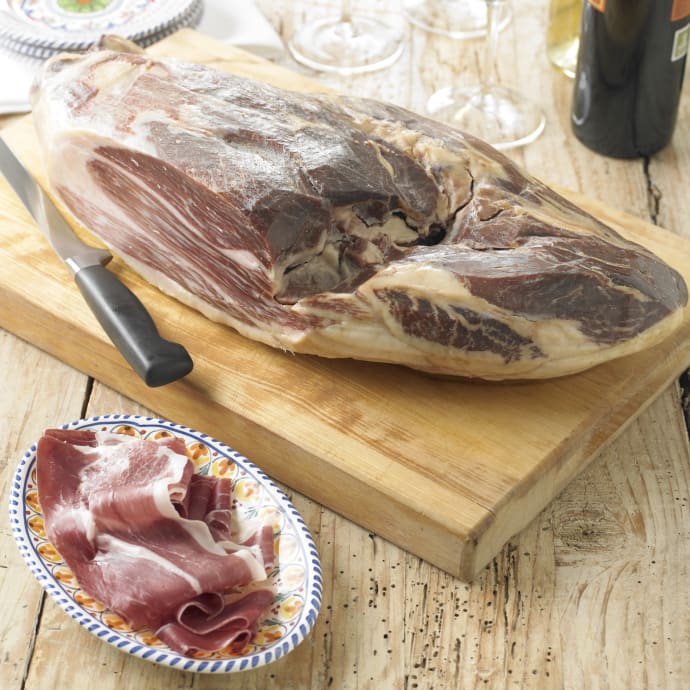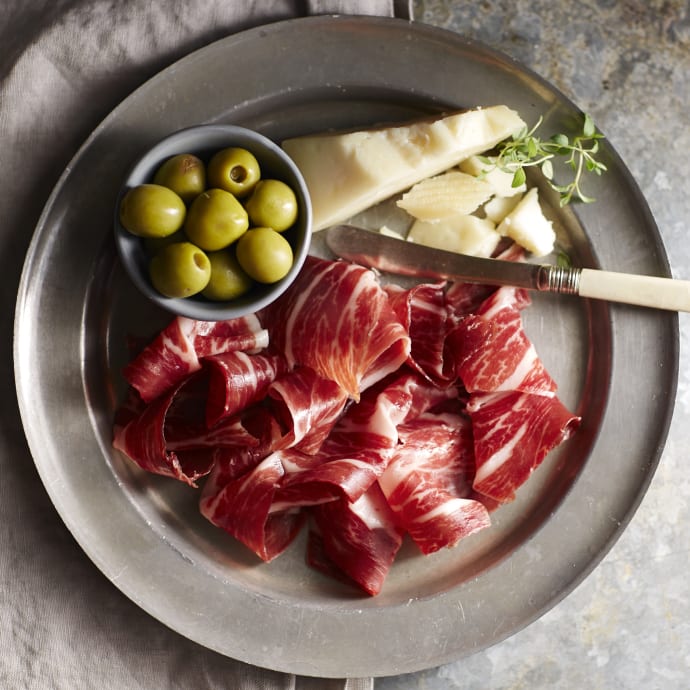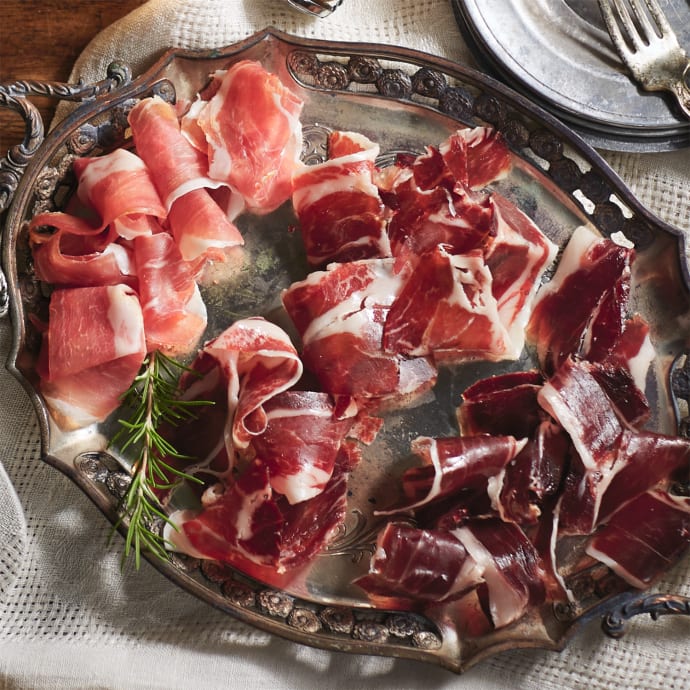Leslie Cole
For lovers of all things piggy, the expected arrival early this year of iberico ham (jamon iberico), the Perigord truffle of the pork world, was cause for celebration. Despite plenty of promises, the wait isn't over yet.
Streaked with creamy, nutty-tasting fat and so red it's nearly purple, the salt- and air-cured Spanish mountain ham, known also as pata negra (Spanish for black foot or black hoof), is widely acknowledged as the world's greatest.
"It's fantastic," says Steve Jones of Steve's Cheese in Northwest Portland, who tasted the most prized type, the acorn-fed jamon iberico de bellota, several years back at Harrods in London. "It is really hard to forget. The acorns impart a definite nuttiness."
A popular bar snack in Spain (some would call it a national obsession), iberico ham, like its everyday cousin, serrano, is a meatier, gutsier nibble than a delicate slice of prosciutto.
The meat comes from free-range Iberian hogs, a boarlike heirloom breed that roams Western Andalusia gorging on wild acorns. The breed, the feed and the fact each whole-leg ham dry-cures for two to four years, accounts for its appeal and its exorbitant price: around $1,200 for a whole ham, although you can buy it by the slice ($50 to $100 a pound, depending on the grade).
Trouble is, it's never been sold on American shores because until recently Spain lacked a USDA-certified slaughterhouse for it. (Serrano ham gets around that because it's butchered in Holland, which does have USDA facilities, and then sent back to Spain for curing.)
That changed in 2005, when a small Spanish operation called Fermin built a USDA-approved facility and was approved to export iberico pork products to the U.S. Though a few cases of chorizo and salchichon, dry-aged sausages made from the vaunted pork, slipped into Portland last fall (Pastaworks sold them locally for about a month), the shipments stopped, and there's still no sign of that ham.
What's the holdup?
It boils down to missing paperwork, say folks close to the process.
"For the last six months, we've been on a sort of go-slow," says Taylor Griffin, a partner in Fermin USA, the U.S. subsidiary of the Spanish producer. (Another partner in the venture is Spanish chef Jose Andres, who owns Jaleo and six other restaurants around Washington, D.C.)
"We had to verify some of the processing steps in a scientific way for USDA, and they stopped us from exporting more product until we did these things."
Fermin, Griffin says, was "delisted" by USDA officials but is in the process of re-listing. What should have taken 90 days to sort out has taken six months, he says. Within a month he expects to see chorizo and salchichon, spicy, dry-cured sausages made from iberico pork. The chewy, deep-red chorizo is flavored with smoky pimenton; the wine-colored salchichon flecked with black pepper.
Soon after that, Griffin expects lomo, cured pork loin. The first iberico hams should arrive by summer, but it could be August 2008 before anyone sees the top-grade belotta hams, which require longer aging.
Don Harris of Spanish food purveyor La Tienda, a mail-order and online company based in Virginia, says the delay had nothing to do with the products or the processor not meeting U.S. standards.
"It was purely a clerical error. But once the clerical error happens, it takes on a life of its own."
Now "it's been all ironed out" between the Spanish government and USDA officials, he says, and ham could be in hand as early as May.
That would surely please the 300 customers on his waiting list, all of whom have paid $200 deposits for the privilege of getting in on the first shipment.
Fortunately for anyone who pays the price, a little goes a long way. Iberico ham, like its more common cousin, serrano, is meant to be nibbled as a snack, in small, bite-sized slices.
"It's got to be really thin, and it's cut parallel to the hoof, rather than across the grain," Harris says, noting that in Spain barmen slice it to order using a special holder and a long, flexible knife called a cuchillo jamonero.
If you want to capture the spirit of a tapas bar, serve it alongside some olives, toasted almonds and a glass of sherry. And be sure to eat the ham at room temperature to get the most flavor out of that luscious fat.
Another thing about that fat: Peter Kaminsky, author of "Pig Perfect," points out that about 55 percent of it is monounsaturated (the type that's in olive oil) and another 10 percent to 15 percent polyunsaturated because of all those acorns the forest-roaming hogs ingest on their way to becoming meat.
But the reason to buy this ham, if only a single slice, is not good fats. It's good flavor.

 SHIPS FREE
SHIPS FREE SHIPS FREE
SHIPS FREE SHIPS FREE
SHIPS FREE



 SHIPS FREE
SHIPS FREE







